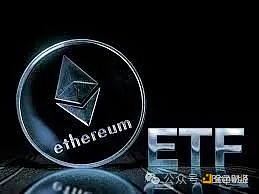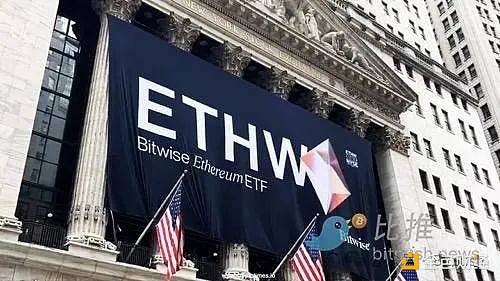Author: Tom Carreras, Benjamin Schiller; Source: Coindesk; Compiler: BitpushNews Mary Liu
For many investors, the performance of spot Ethereum (ETH) exchange-traded funds (ETFs) has been disappointing.
While spot Bitcoin ETFs have handled nearly $19 billion in inflows in 10 months, the Ethereum ETF, which began trading in July, has failed to attract the same interest.
To make matters worse, Grayscale's ETHE, which existed as an Ethereum Trust before converting to an ETF, has suffered a large number of redemptions, and demand from other similar funds has failed to offset these redemptions.

This means that since its launch, the net outflow of spot Ethereum ETFs has reached $556 million. This week alone, these products have seen net outflows of $8 million, according to Farside.
So why are Ethereum ETFs performing so differently? There could be several reasons.
Background on Inflows
First, it’s important to note that Ethereum ETFs haven’t performed well compared to Bitcoin ETFs, which have broken so many records that they are arguably the most successful ETFs ever.
For example, BlackRock and Fidelity’s ETFs, IBIT and FBTC, raised $4.2 billion and $3.5 billion, respectively, in their first 30 days, breaking a record set by another BlackRock fund, Climate Conscious, which raised $2.2 billion in its first month after listing (August 2023).

Nate Geraci, president of The ETF Store, said that although Ethereum ETFs failed to "make a splash," three of the funds are still among the 25 best-performing ETFs this year.
BlackRock's ETHE, Fidelity's FBTC, and Bitwise's ETHW have attracted nearly $1 billion, $367 million, and $239 million in assets, respectively - this is already very good for funds that have been established for two and a half months.
Geraci told CoinDesk: "In terms of inflows, spot Ethereum ETFs will never be able to challenge spot Bitcoin ETFs."
“If you look at the underlying spot market, Ethereum’s market cap is about a quarter of Bitcoin’s. That should be a reasonable proxy for the long-term demand for a spot Ether ETF relative to a spot Bitcoin ETF.”
The problem is that Grayscale’s ETHE outflows have overshadowed the performance of these funds.
ETHE was launched as a trust in 2017, and for regulatory reasons, it was originally designed in a way that didn’t allow investors to redeem their ETF shares — the money was trapped in the product. That changed on July 23, when Grayscale received approval to convert its trust into a formal ETF.
At the time of the conversion, ETHE had about $1 billion in assets, and while some of those assets were transferred by Grayscale itself to another of its funds, the Ethereum Mini ETF, ETHE has suffered nearly $3 billion in outflows.
Notably, Grayscale’s Bitcoin ETF – GBTC – has experienced the same, having handled more than $20 billion in outflows since its conversion in January. Still, the outperformance of BlackRock and Fidelity’s spot Bitcoin ETFs has more than offset GBTC’s losses.
Lack of Staking Yield
A big difference between Bitcoin and Ethereum is that investors can stake Ethereum – essentially locking it up in the Ethereum network to earn yields paid out in Ethereum.
However, Ethereum ETFs in their current form don’t allow investors to participate in staking. As a result, holding Ethereum through an ETF means missing out on that yield (currently around 3.5%) and paying a management fee of 0.15% to 2.5% to the issuer.
While some traditional investors don’t mind giving up yield in exchange for the convenience and security of an ETF, it makes sense for crypto-native investors to look for alternative ways to hold Ethereum.
“If you’re a competent fund manager who has a basic understanding of the crypto markets and is managing someone’s money, why would you buy an Ethereum ETF right now?” Adam Morgan McCarthy, an analyst at crypto data firm Kaiko Research, told CoinDesk.
“You can pay for exposure to ETH (the underlying asset is custodied at Coinbase), or buy the underlying asset yourself and stake it with the same provider to get a certain yield,” McCarthy said.
Marketing woes
Another hurdle facing an Ethereum ETF is that it may be difficult for some investors to understand Ethereum’s core use case as it attempts to take a leading position in multiple different areas of cryptocurrency.
Bitcoin has a hard cap on its issuance: There will never be more than 21 million bitcoins issued. That makes it relatively easy for investors to view it as “digital gold” and a potential hedge against inflation.
Explaining why the decentralized, open-source smart contract platform is important — and, more importantly, why ETH will continue to increase in value — is another matter.
“One of the challenges facing an Ethereum ETF in breaking into the 60/40 baby boomer world is distilling its purpose/value into something easily understandable,” Bloomberg Industry Research ETF analyst Eric Balchunas wrote in May.
McCarthy agreed, telling CoinDesk: “The concept of ETH is more complex than other cryptocurrencies and is not well suited to being explained in a simple sentence.”

As a result, crypto index fund Bitwise recently launched an educational advertising campaign that emphasizes Ethereum’s technical advantages, which is necessary.
Zach Pandl, head of research at Grayscale, told CoinDesk: “As investors learn more about stablecoins, decentralized finance, tokenization, prediction markets, and the many other applications powered by Ethereum, they will enthusiastically embrace both technologies and Ethereum ETPs listed in the U.S..”
Poor value for money
In fact, ETH itself has not performed too well compared to BTC this year.
The second-largest cryptocurrency by market value is up just 4% since Jan. 1, while BTC is up 42% and continues to hover near its 2021 all-time high.
Brian Rudick, head of research at cryptocurrency trading firm GSR, told CoinDesk: “One factor behind the success of bitcoin ETFs is investor risk-taking and fear of missing out, and these ETFs are still largely driven by retail investors, which in turn was driven by BTC’s 65% rally at the ETF launch and its subsequent 33% rally.”
Since the ETF launch, ETH’s price has fallen 30%, which has greatly dampened retail enthusiasm for buying these funds, and people’s evaluation of Ethereum is mediocre, with some considering it to be between Bitcoin (the best monetary asset) and Solana (the best high-performance smart contract blockchain).
Unattractive valuations
Finally, traditional investors may simply not find ETH’s valuation attractive at these levels.
With a market cap of about $290 billion, ETH’s valuation is already higher than any bank in the world, and second only to JPMorgan Chase and Bank of America, which have market caps of $608 billion and $311 billion, respectively.
While this may seem like a comparison between apples and oranges, Quinn Thompson, founder of crypto hedge fund Lekker Capital, told CoinDesk that ETH is also highly valued compared to tech stocks.
Quinn Thompson wrote in September that ETH's valuation "is now worse than other assets because no valuation framework can justify its price. Either the price must come down or a new generally accepted asset valuation framework needs to be formed."
 Weatherly
Weatherly








